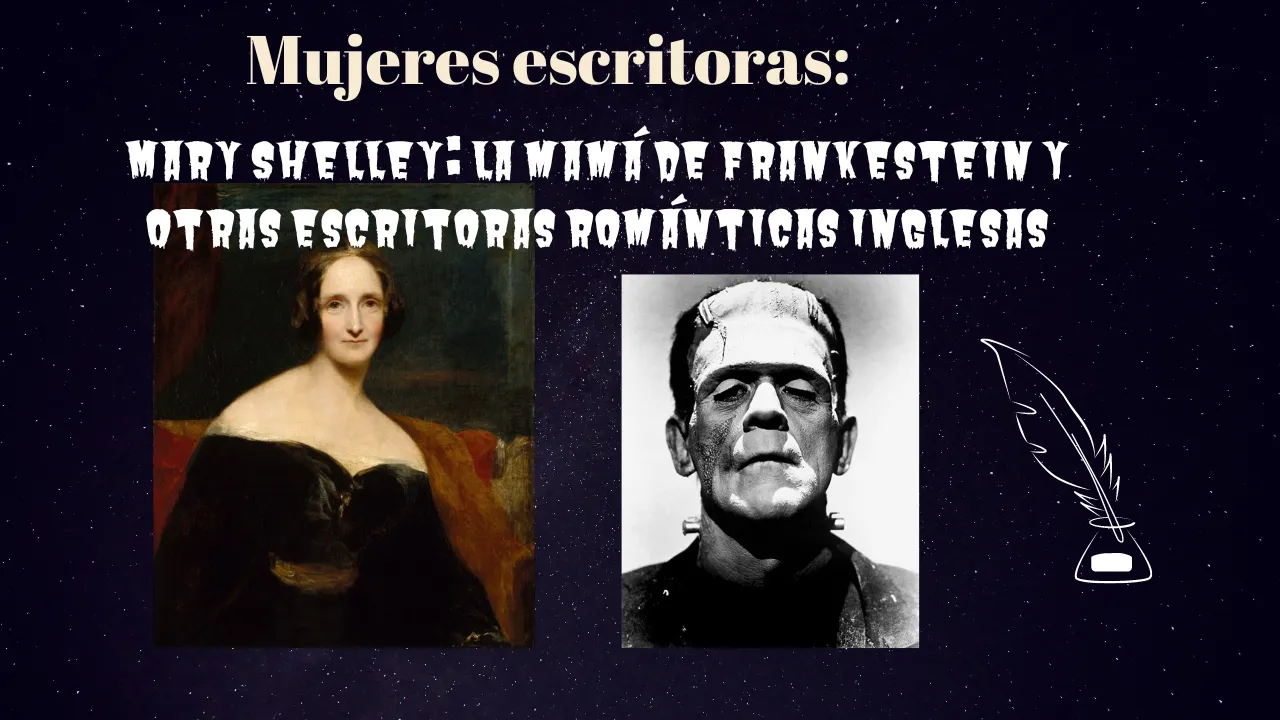
Banner diseñado por mí en canva.com fuente retrato Mary Shelley fuente retrato Frankestein
Banner designed by me on canva.com source portrait Mary Shelley source portrait Frankestein
MARY SHELLEY: LA MAMÁ DE FRANKESTEIN Y OTRAS ESCRITORAS ROMÁNTICAS INGLESAS
Pero tras el ángel se oculta el monstruo: el anverso de la idealización masculina de la mujer es el miedo a la feminidad. El monstruo mujer es aquella mujer que no renuncia a tener su propia personalidad, que actúa según su propia iniciativa, que tiene una historia que contar –en resumen, una mujer que rechaza el papel sumiso que el machismo te ha asignado.
Toril Moi. Teoría Literaria Feminista
Como suelo decirle a mis alumnos, toda obra literaria es hija de su tiempo. En el texto anterior sobre mujeres escritoras del Romanticismo escribí sobre el contexto cultural en el que escribieron las escritoras hispanoamericanas románticas, por lo tanto no me extenderé sobre el Romanticismo y la nueva sensibilidad que despertó en el arte y en la vida. https://peakd.com/hive-179291/@beaescribe/mujeres-escritoras-las-escritoras-romanticas-hispanoamericanas-spanish-english
En el caso de las mujeres escritoras inglesas de la época romántica, finales del siglo XVIII y primera mitad del siglo XIX, considero que hay factores históricos y políticos que es importante señalar: el largo reinado de 70 años de Victoria de Inglaterra, en cuyo gobierno se expande el Imperio británico. Una mujer detentó el poder buena parte del siglo. Por otra parte, es la época en la que se consolida la revolución Industrial, liderada por Inglaterra, una revolución que cambia por completo la estructura social y económica del mundo. El mundo se acelera y se transforma a una velocidad alucinante. Hay un gran desarrollo científico y tecnológico.

Fuente Reina Victoria de Inglaterra 1819-1901
Mary Shelley, la mamá de Frankestein (1797-1851)
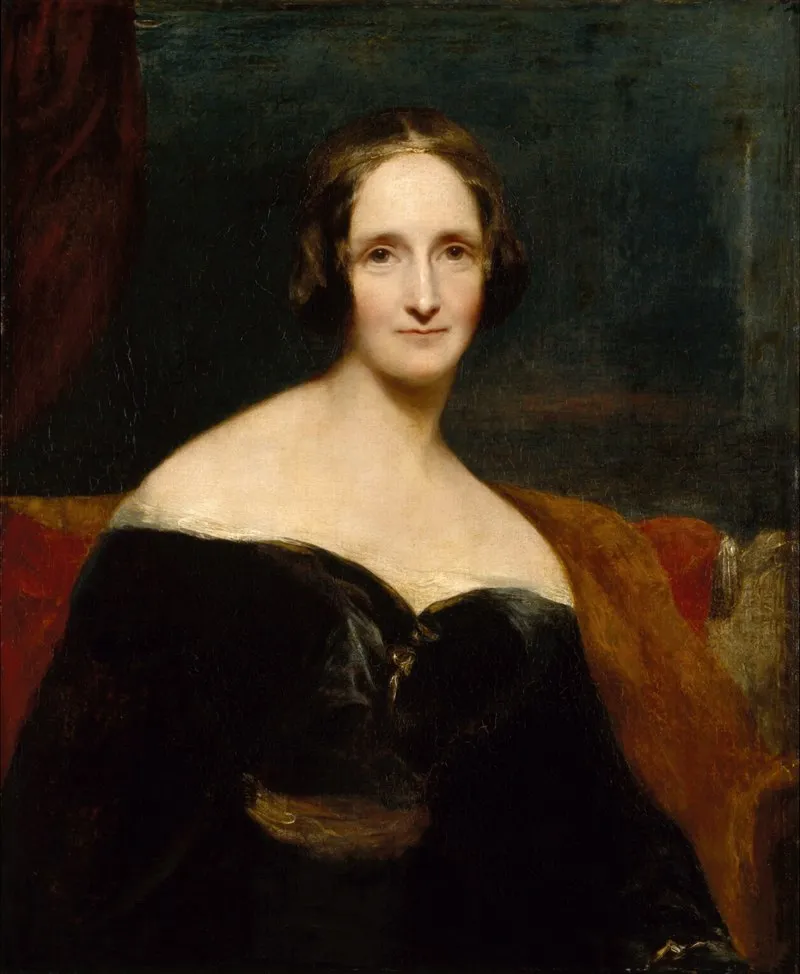
Fuente
La novelista, dramaturga y ensayista británica nació en Londres el 30 de agosto de 1797 en un hogar conformado por dos destacados filósofos, el político William Godwin y la filósofa Mary Wollstonecraft, quien murió de una infección postparto, luego de darla a luz. Su madre escribió un libro fundacional del feminismo “La Vindicación de los Derechos de la Mujer”. Tres años después su padre volvió a casarse con una vecina, Mary Jane Clairmont.
En 1814, cuando tenía 17 años, se enamoró de un seguidor político de su padre, el poeta Percy Bysshe Shelley, quien era casado, con quien viajó por Europa, junto a su hermanastra Claire Clairmont. Al regresar a inglaterra estaba embarazada y durante dos años sufrieron el rechazo social. Se casaron finalmente en 1816, cuando la esposa de Shelley, Harriet, se suicidó. La trágica historia de su amor bien podría haber sido el argumento de una novela de su época, recordemos dos personajes femeninos emblemáticos del XIX, Madame Bovary y Ana Karenina, que tienen un final trágico precisamente por enamorarse de quien no debían.
La obra más conocida de Shelley, la novela gótica “Frankenstein o el moderno Prometeo”, fue escrita en 1818, durante un verano que compartieron la escritora y su esposo con George Gordon Byron, John William Polidori y Claire Clairmont. Se considera la primera novela de ciencia ficción moderna. Como la obra de otras escritoras de la época fue publicada anónimamente.
Pero más allá del imaginario que han creado las múltiples versiones cinematográficas o de televisión que conocemos, vinculado al terror, a lo monstruoso, es interesante observar el trasfondo ético de la novela, que expresa la preocupación por la manera en que los avances científicos y técnicos habían deshumanizado la sociedad. “El Doctor Jekyll y el Señor Hyde” de Stevenson también nos conecta con un personaje científico enajenado.
En 1822 su esposo Percy se ahogó durante una tormenta en la bahía de La Spezia, se habían mudado a Italia pocos años antes. Dos de sus hijos murieron pequeños, sólo logró sobrevivir el menor, Percy Florence. Los últimos años de su vida regresó a Inglaterra y escribió novelas históricas y biografías. Shelley murió en 1851 a los 53 años de un tumor cerebral.

George Sand (1804-1876)
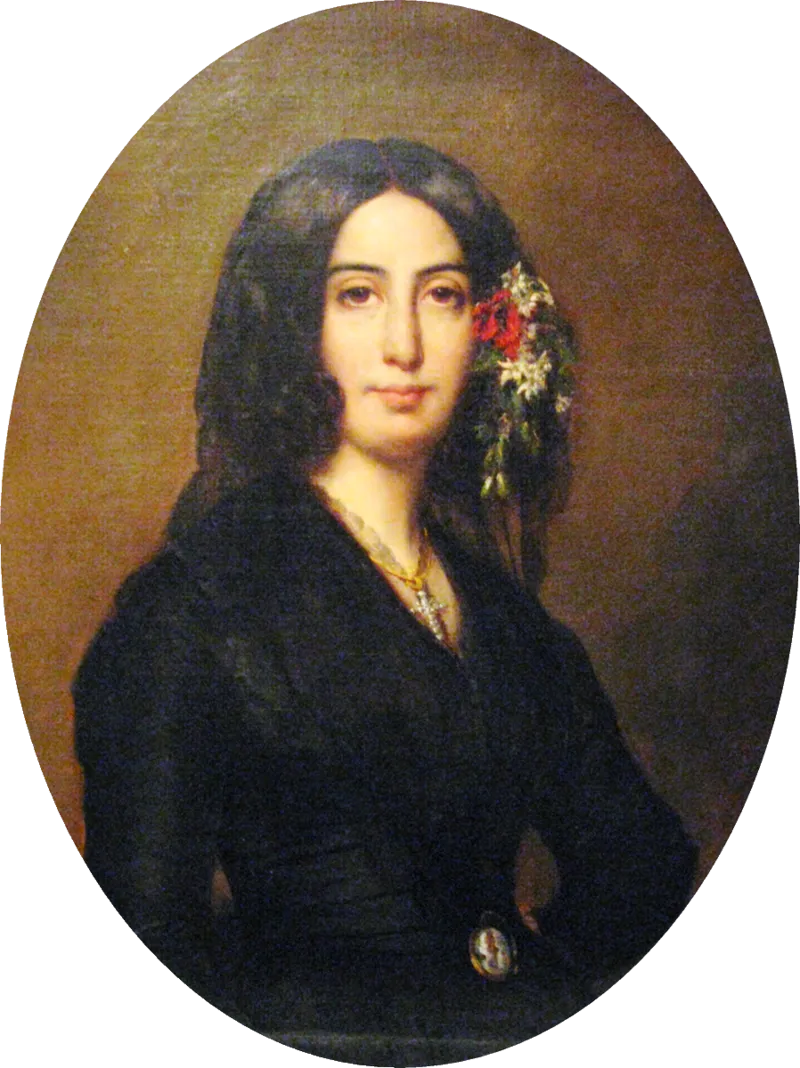
Fuente
George Sand es el seudónimo de la escritora francesa Aurore Dupin de Dudevant, quien nació en París el 1 de julio de 1804, una de las escritoras más destacadas del Romanticismo. Durante el exilio de su familia en España, en 1808, su madre le confeccionó por primera vez las vestimentas masculinas que escandalizaron a la sociedad de su época. En 1809 la familia regresó a Francia y se instalaron en la finca Nohant que pertenecía a su abuela paterna, a pesar de que inicialmente su abuela había rechazado el matrimonio desigual de sus padres, su madre era de origen humilde y su padre de origen noble.
En 1821 murió su abuela paterna, Marie-Aurore de Saxe, con quien vivía la escritora francesa, quien le dejó de herencia toda su fortuna. Un año después se casó con el barón Casimir Dudevant, tuvo con él dos hijos, Maurice y Solange, no fue feliz con el barón, lo abandonó en 1831 y se fue a París, llevándose a sus hijos. La separación legal fue en 1835 y la escritora se quedó con la custodia. Uno de los temas recurrentes de sus novelas es precisamente la infelicidad conyugal.
Cuando se instaló en París se formó en diversas expresiones artísticas, pero decidió dedicarse a la literatura. Su primera novela “Rosa y Blanca” la escribió en 1831, junto a su pareja del momento, Jules Sandeau. Con las primeras letras de su apellido conformó su seudónimo, George Sand, pero se separaron poco tiempo después.
Con su primera novela en solitario “Indiana”, publicada en 1832, logró la fama literaria. Con sus atuendos masculinos entró en lugares donde las damas no entraban. Quienes admiraron sus obras no tuvieron problemas en aceptar su atuendo. En ese tiempo tuvo amistad y romance con algunos grandes artistas de la época. En 1831 conoció al compositor Frederik Chopin, con quien tuvo un apasionado romance. En una de sus novelas más conocidas “Lucrezia Floriano”, uno de los personajes protagónicos es un príncipe italiano enfermo, se inspiró en Chopin y fue acusada de caricaturizarlo. En el verano de 1833 tuvo una relación sentimental con el poeta Alfred de Musset, quien le dedicó su libro “Confesión de un hijo del siglo”.
Formaron parte de su círculo de amigos el compositor Franz Liszt, el pintor Eugène Delacroix, el escritor Heinrich Heine, y así también algunos de los grandes escritores de la época Victor Hugo, Honoré de Balzac, Gustave Flaubert y Julio Verne. Sin duda la herencia recibida de su abuela noble le dio a Sand libertad económica, le permitió vivir a su aire sin tener que dar explicaciones. Fue la más afortunada de las escritoras románticas. Murió a los 71 años en su castillo en Nohant víctima de un cáncer gástrico.

Emily Brontë y sus hermanas (1818-1848)
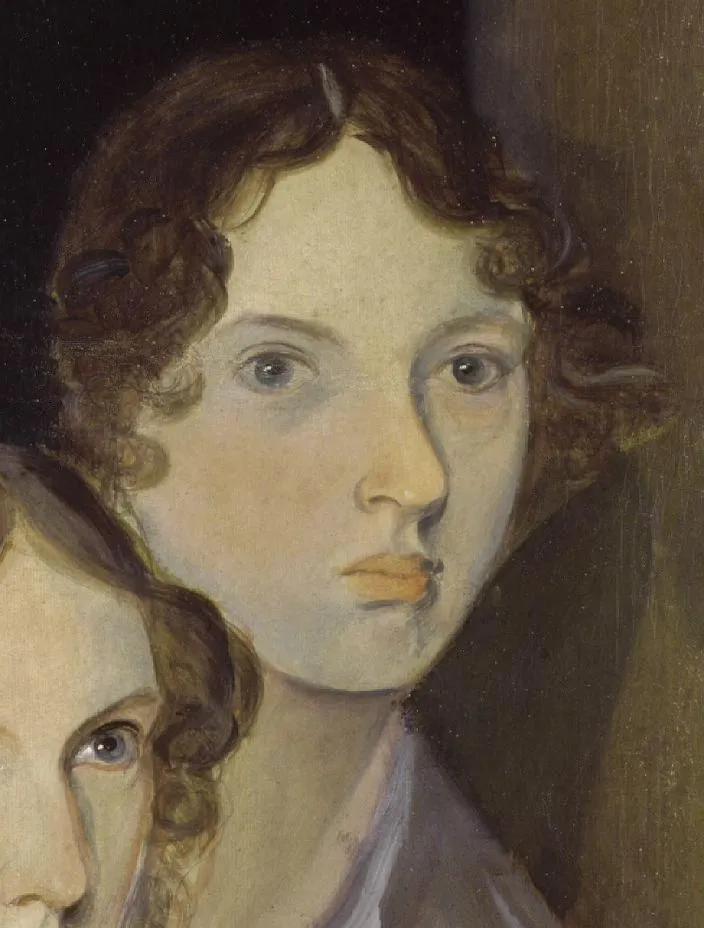
Emily Brontë
Fuente

Charlotte Brontë
Fuente
Emily Brontë nació el 30 de julio de 1818, fue la quinta de seis hermanos. Cuando apenas tenía un año de edad su madre murió. En 1824 Emily y sus hermanas fueron enviadas a un internado, junto con sus hermanas mayores, María y Elizabeth en Lacanshire, donde enfermaron de tuberculosis, un año después María y Elizabeth murieron víctimas de la tuberculosis y las niñas menores fueron retiradas del internado. Años después Charlotte se inspiró en el colegio de Lancanshire para escribir su novela “Jane Eyre”.
Las niñas Brontë y su hermano Branwell imaginaron tres países, —Angria, Gondal y Glass Town— un mundo ficcional en el que ocurrían las historias que inventaban. En 1838 Emily comenzó a trabajar como institutriz en Halifax. Posteriormente, Emily y Charlotte volvieron a estudiar en un colegio privado en Bruselas y regresaron a Inglaterra al morir la tía que administraba la casa familiar, en adelante Emily se encargó de administrarla.
En 1846 las tres hermanas Brontë, Emily, Charlotte y Anne publicaron un libro de poesía en conjunto, en el que destacaron los poemas de Emily. Quien al año siguiente publicó su novela más conocida “Cumbres borrascosas” bajo el seudónimo masculino Ellis Bell, debido a las dificultades que tenían las mujeres del siglo XIX en el reconocimiento de su trabajo literario. Las tres hermanas publicaron bajo seudónimo masculino, novelas de personajes femeninos valientes, independientes e inteligentes, lo que suponía un escándalo para la época, por eso publicaron sus obras con seudónimos masculinos: Currer Bell, Ellis Bell y Acton Bell.
Infelizmente, Emily murió de tuberculosis cuando apenas tenía 30 años, debido a un resfriado que había contraído en el funeral de su hermano Branwell. Anne murió un año después de la misma enfermedad y así también Charlotte, en 1855. En octubre de 2022, la directora Frances O’Connor estrenó la película “Emily” basada en la vida de la escritora británica.

George Eliot (1819-1880)
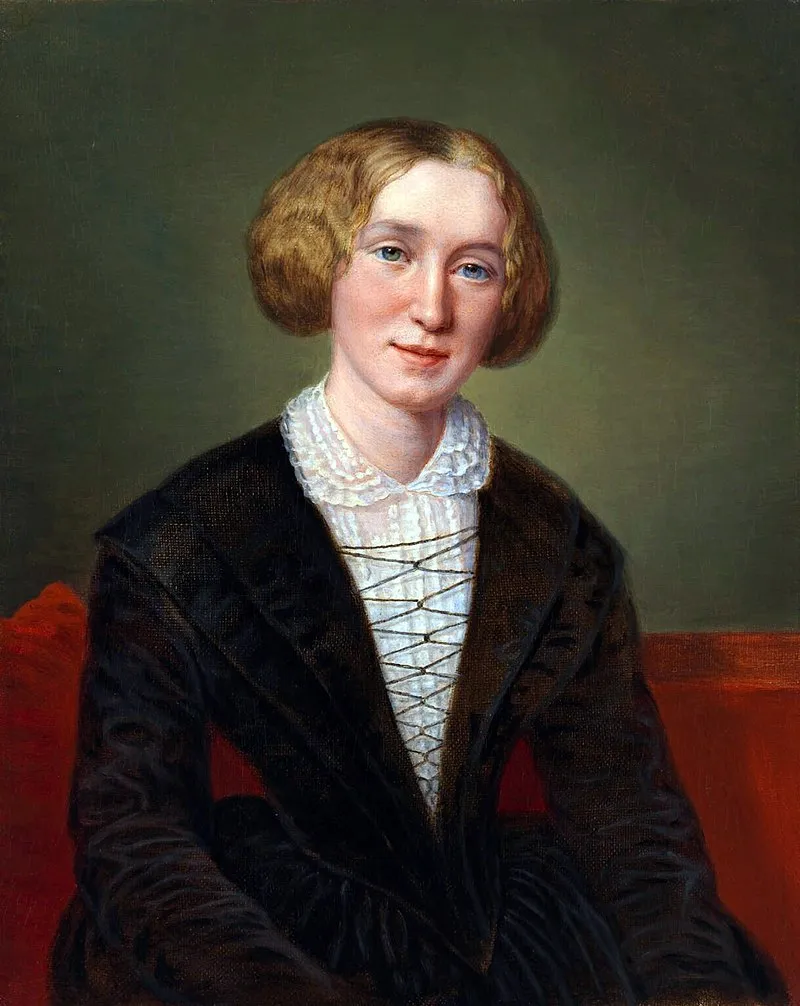
Fuente
Como ocurrió con otras escritoras de la época romántica la escritora británica Mary Ann Evans utilizó un seudónimo masculino para publicar sus obras: George Eliot. La novelista, poetisa, periodista y traductora británica nació en Warwickshire el 22 de noviembre de 1819, es considerada una de las principales escritoras de la época victoriana.
La escritora era de origen provincial, es por eso que sus sietes novelas están ambientadas en la campiña inglesa y en su estilo de vida: Adam Bede (1859), El molino del Floss (1860), Silas Marner (1861), Romola (1862-63), Felix Holt, el Radical (1866), Middlemarch (1871-72) y Daniel Deronda (1876). Su padre era granjero y su madre era la hija del dueño del molino local. Pero ella desde muy joven tuvo un gran interés por la lectura y el conocimiento y poco entusiasmo por el matrimonio y la maternidad. Su padre apoyó su interés por el estudio.
Su madre murió en 1836, cuando tenía 16 años, razón por la cual abandonó la educación formal para cuidar a su padre y adminitrar la casa familiar. Sin embargo, continuó su educación con un preceptor, tuvo especial interés por autores clásicos griegos. Su hermano Isaac se casó cinco años después y se hizo cargo de la casa familiar. Ella y su padre se mudaron a Coventry, donde entró en contacto con librepensadores como Ralph Waldo Emerson, Harriet Martineau, Herbert Spencer y Stuart Mill, quien apoyó los derechos de las mujeres. Así también tradujo a los filósofos Spinoza, Feuerbach y David Strauss.
En 1851 se enamoró del filósofo, científico y periodista George Henry Lewes, quien era un hombre casado, con quien mantuvo una relación amorosa hasta que él murió de cáncer en 1878. Fue su gran y único amor. Dos años después se casó con un amigo cercano de ambos, John Cross.
Su primer libro publicado "Escenas de la vida clerical" (1858) lo conformaron tres relatos extensos que había publicado en Blackwood's Magazine con el pseudónimo masculino de George Eliot, quería asegurarse de que su obra fuera tomada en serio. A diferencia de otras autoras de su tiempo como Jane Austin o las Hermanas Brontë, sus novelas no son de tema sentimental, hay un mayor interés en retratar la sociedad, al igual que algunos de los grandes escritores realistas del siglo XIX.

Bibliografía
Ecker, Gisela. Estética feminista. Barcelona: Icaria, 1986.
Moi, Toril. Teoría literaria feminista. (Traducción de Amaia Barcena). Madrid: Ediciones Cátedra, 1999.
Russotto, Márgara. Tópicos de retórica femenina. Memoria y pasión del género. Caracas: Monte Ávila Editores/Centro de Estudios Latinoamericanos Rómulo Gallegos, 1993.
Mujeres del Romanticismo link https://fundacionorotava.org/exposiciones/mujeres-del-romanticismo/
Biografía de Mary Shelley https://es.wikipedia.org/wiki/Mary_Shelley
Biografía de George Sand https://es.wikipedia.org/wiki/George_Sand
Biografía de Emily Brontë https://es.wikipedia.org/wiki/Emily_Bront%C3%AB
Biografía de George Eliot https://es.wikipedia.org/wiki/George_Eliot

Las vidas de las escritoras inglesas de la era victoriana estuvieron llenas de tragedias y grandes pasiones, pero todas se enfrentaron con valentía a la rígida sociedad de su tiempo para escribir su obra. Espero que hayas disfrutado estas líneas. Para quienes no hayan leído los post de las entradas anteriores de la serie "Mujeres escritoras" les dejó los links para que los puedan leer.
@beaescribe/mujeres-escritoras-quien-las-borro
@beaescribe/mujeres-escritoras-safo-y-otras
@beaescribe/mujeres-escritoras-las-trobairitz-medievales-spanish-english
@beaescribe/mujeres-escritoras-el-renacimiento-spanish-english
@beaescribe/mujeres-escritoras-sei-shonagon-spanish-english
@beaescribe/mujeres-escritoras-barroco-spanish-english
@beaescribe/mujeres-escritoras-germaine-de-stael-spanish-english
@beaescribe/mujeres-escritoras-las-escritoras-romanticas-hispanoamericanas-spanish-english

MARY SHELLEY: FRANKESTEIN'S MOTHER AND OTHER ENGLISH ROMANCE WRITERS
But behind the angel hides the monster: the obverse of the masculine idealization of woman is the fear of femininity. The female monster is a woman who does not renounce her own personality, who acts on her own initiative, who has a story to tell - in short, a woman who rejects the submissive role that machismo has assigned to her.
Toril Moi. Feminist Literary Theory
As I usually tell my students, every literary work is a child of its time. In the previous text on women writers of Romanticism I wrote about the cultural context in which Spanish American women romantic writers wrote, so I will not expand on Romanticism and the new sensibility it awakened in art and in life. https://peakd.com/hive-179291/@beaescribe/mujeres-escritoras-las-escritoras-romanticas-hispanoamericanas-spanish-english
In the case of English women writers of the Romantic era, the end of the 18th century and the first half of the 19th century, I believe that there are historical and political factors that are important to point out: the 70-year long reign of Victoria of England, during whose government the British Empire expanded. A woman held power for a good part of the century. On the other hand, it is the time in which the Industrial Revolution, led by England, is consolidated, a revolution that completely changes the social and economic structure of the world. The world accelerates and transforms at an amazing speed. There is a great scientific and technological development.

Source Queen Victoria of England 1819-1901
Mary Shelley, Frankenstein's mother (1797-1851)

Source
The British novelist, playwright and essayist was born in London on August 30, 1797 to two prominent philosophers, the politician William Godwin and the philosopher Mary Wollstonecraft, who died of a postpartum infection after giving birth to her. Her mother wrote a foundational book of feminism "The Vindication of the Rights of Woman". Three years later her father remarried a neighbor, Mary Jane Clairmont.
In 1814, when she was 17 years old, she fell in love with a political follower of her father, the poet Percy Bysshe Shelley, who was married, with whom she traveled through Europe, together with her half-sister Claire Clairmont. When she returned to England she was pregnant and for two years they suffered social rejection. They were finally married in 1816, when Shelley's wife, Harriet, committed suicide. The tragic story of their love could well have been the plot of a novel of their time, remember two emblematic female characters of the nineteenth century, Madame Bovary and Anne Karenina, who have a tragic end precisely because they fell in love with the wrong person.
Shelley's best known work, the Gothic novel "Frankenstein or the Modern Prometheus", was written in 1818, during a summer shared by the writer and her husband with George Gordon Byron, John William Polidori and Claire Clairmont. It is considered the first modern science fiction novel. Like the work of other women writers of the time, it was published anonymously.
But beyond the imaginary created by the multiple film or television versions we know, linked to terror, to the monstrous, it is interesting to note the ethical background of the novel, which expresses concern about the way in which scientific and technical advances had dehumanized society. Stevenson's "Doctor Jekyll and Mr. Hyde" also connects us with an alienated scientific character.
In 1822 her husband Percy drowned during a storm in the bay of La Spezia, they had moved to Italy a few years earlier. Two of her children died young, only the youngest, Percy Florence, survived. The last years of his life he returned to England and wrote historical novels and biographies. Shelley died in 1851 at the age of 53 from a brain tumor.

George Sand (1804-1876)

Source
George Sand is the pseudonym of the French writer Aurore Dupin de Dudevant, who was born in Paris on July 1, 1804, one of the most prominent writers of Romanticism. During her family's exile in Spain, in 1808, her mother made for her for the first time the masculine dresses that scandalized the society of her time. In 1809 the family returned to France and settled on the Nohant estate that belonged to his paternal grandmother, although his grandmother had initially rejected the unequal marriage of his parents, his mother being of humble origin and his father of noble birth.
In 1821 her paternal grandmother, Marie-Aurore de Saxe, with whom the French writer lived, died and left her all her fortune as an inheritance. A year later she married Baron Casimir Dudevant, had two children with him, Maurice and Solange, was not happy with the baron, she left him in 1831 and went to Paris, taking her children with her. The legal separation was in 1835 and the writer kept custody. One of the recurring themes of her novels is precisely marital unhappiness.
When she settled in Paris she was trained in various artistic expressions, but decided to devote herself to literature. She wrote her first novel "Rose and White" in 1831, with her partner of the time, Jules Sandeau. With the first letters of her surname she formed her pseudonym, George Sand, but they separated shortly after.
With his first solo novel "Indiana", published in 1832, he achieved literary fame. With his masculine attire he entered places where ladies did not enter. Those who admired his works had no problem accepting his attire. At that time she had friendship and romance with some great artists of the time. In 1831 she met the composer Frederik Chopin, with whom she had a passionate affair. In one of her best known novels "Lucrezia Floriano", one of the main characters is a sick Italian prince, she was inspired by Chopin and was accused of caricaturing him. In the summer of 1833 she had a sentimental relationship with the poet Alfred de Musset, who dedicated his book "Confession of a Son of the Century" to her.
His circle of friends included the composer Franz Liszt, the painter Eugène Delacroix, the writer Heinrich Heine, as well as some of the great writers of the time, Victor Hugo, Honoré de Balzac, Gustave Flaubert and Jules Verne. Undoubtedly the inheritance received from her noble grandmother gave Sand economic freedom, allowing her to live as she pleased without having to explain herself. She was the luckiest of the romantic writers. She died at the age of 71 in her castle in Nohant, victim of gastric cancer.

Emily Brontë y sus hermanas (1818-1848)

Emily Brontë
Source

Charlotte Brontë
Source
Emily Brontë was born on July 30, 1818, the fifth of six children. When she was barely a year old her mother died. In 1824 Emily and her sisters were sent to a boarding school, along with her older sisters, Mary and Elizabeth in Lacanshire, where they fell ill with tuberculosis, a year later Mary and Elizabeth died victims of tuberculosis and the younger girls were removed from the boarding school. Years later Charlotte was inspired by the Lancanshire school to write her novel "Jane Eyre".
The Brontë girls and their brother Branwell imagined three countries, -Angria, Gondal and Glass Town- a fictional world in which the stories they invented took place. In 1838 Emily began working as a governess in Halifax. Later, Emily and Charlotte returned to study at a private school in Brussels and returned to England upon the death of the aunt who managed the family home, whereupon Emily took over the management of the family home.
In 1846 the three Brontë sisters, Emily, Charlotte and Anne published a book of poetry together, in which Emily's poems stood out. The following year she published her best known novel "Wuthering Heights" under the male pseudonym Ellis Bell, due to the difficulties that women had in the nineteenth century in the recognition of their literary work. The three sisters published under male pseudonyms, novels of brave, independent and intelligent female characters, which was a scandal for the time, so they published their works under male pseudonyms: Currer Bell, Ellis Bell and Acton Bell.
Unfortunately, Emily died of tuberculosis when she was only 30 years old, due to a cold she had contracted at her brother Branwell's funeral. Anne died a year later of the same disease and so did Charlotte, in 1855. In October 2022, director Frances O'Connor released the film "Emily" based on the life of the British writer.

George Eliot (1819-1880)

Source
As happened with other women writers of the Romantic era, the British writer Mary Ann Evans used a male pseudonym to publish her works: George Eliot. The British novelist, poet, journalist and translator, born in Warwickshire on November 22, 1819, is considered one of the leading writers of the Victorian era.
The writer was of provincial origin, which is why her seven novels are set in the English countryside and its lifestyle: Adam Bede (1859), The Floss Mill (1860), Silas Marner (1861), Romola (1862-63), Felix Holt, the Radical (1866), Middlemarch (1871-72) and Daniel Deronda (1876). Her father was a farmer and her mother was the daughter of the local mill owner. But she from an early age had a keen interest in reading and knowledge and little enthusiasm for marriage and motherhood. Her father supported her interest in study.
His mother died in 1836, when he was 16 years old, which is why he abandoned formal education to take care of his father and manage the family home. However, she continued her education with a preceptor, and had a special interest in classical Greek authors. Her brother Isaac married five years later and took over the family home. She and her father moved to Coventry, where she came into contact with freethinkers such as Ralph Waldo Emerson, Harriet Martineau, Herbert Spencer and Stuart Mill, who supported women's rights. She also translated the philosophers Spinoza, Feuerbach and David Strauss.
In 1851 she fell in love with the philosopher, scientist and journalist George Henry Lewes, who was a married man, with whom she maintained a loving relationship until he died of cancer in 1878. He was her great and only love. Two years later she married a close friend of both, John Cross.
Her first published book "Scenes of Clerical Life" (1858) consisted of three long stories that she had published in Blackwood's Magazine under the male pseudonym of George Eliot, she wanted to make sure that her work was taken seriously. Unlike other female authors of her time such as Jane Austin or the Brontë Sisters, her novels are not sentimental in theme; there is a greater interest in portraying society, just like some of the great realist writers of the 19th century.

Bibliography
Ecker, Gisela. Estética feminista. Barcelona: Icaria, 1986.
Moi, Toril. Teoría literaria feminista. (Traducción de Amaia Barcena). Madrid: Ediciones Cátedra, 1999.
Russotto, Márgara. Tópicos de retórica femenina. Memoria y pasión del género. Caracas: Monte Ávila Editores/Centro de Estudios Latinoamericanos Rómulo Gallegos, 1993.
Mujeres del Romanticismo link https://fundacionorotava.org/exposiciones/mujeres-del-romanticismo/
Biografía de Mary Shelley https://es.wikipedia.org/wiki/Mary_Shelley
Biografía de George Sand https://es.wikipedia.org/wiki/George_Sand
Biografía de Emily Brontë https://es.wikipedia.org/wiki/Emily_Bront%C3%AB
Biografía de George Eliot https://es.wikipedia.org/wiki/George_Eliot

The lives of the English women writers of the Victorian era were full of tragedies and great passions, but they all bravely faced the rigid society of their time to write their work. I hope you have enjoyed these lines. For those of you who haven't read the previous posts in the "Women Writers" series, I've left the links so you can read them.
@beaescribe/mujeres-escritoras-quien-las-borro
@beaescribe/mujeres-escritoras-safo-y-otras
@beaescribe/mujeres-escritoras-las-trobairitz-medievales-spanish-english
@beaescribe/mujeres-escritoras-el-renacimiento-spanish-english
@beaescribe/mujeres-escritoras-sei-shonagon-spanish-english
@beaescribe/mujeres-escritoras-barroco-spanish-english
@beaescribe/mujeres-escritoras-germaine-de-stael-spanish-english
@beaescribe/mujeres-escritoras-las-escritoras-romanticas-hispanoamericanas-spanish-english
Translation to english by deepl.com























